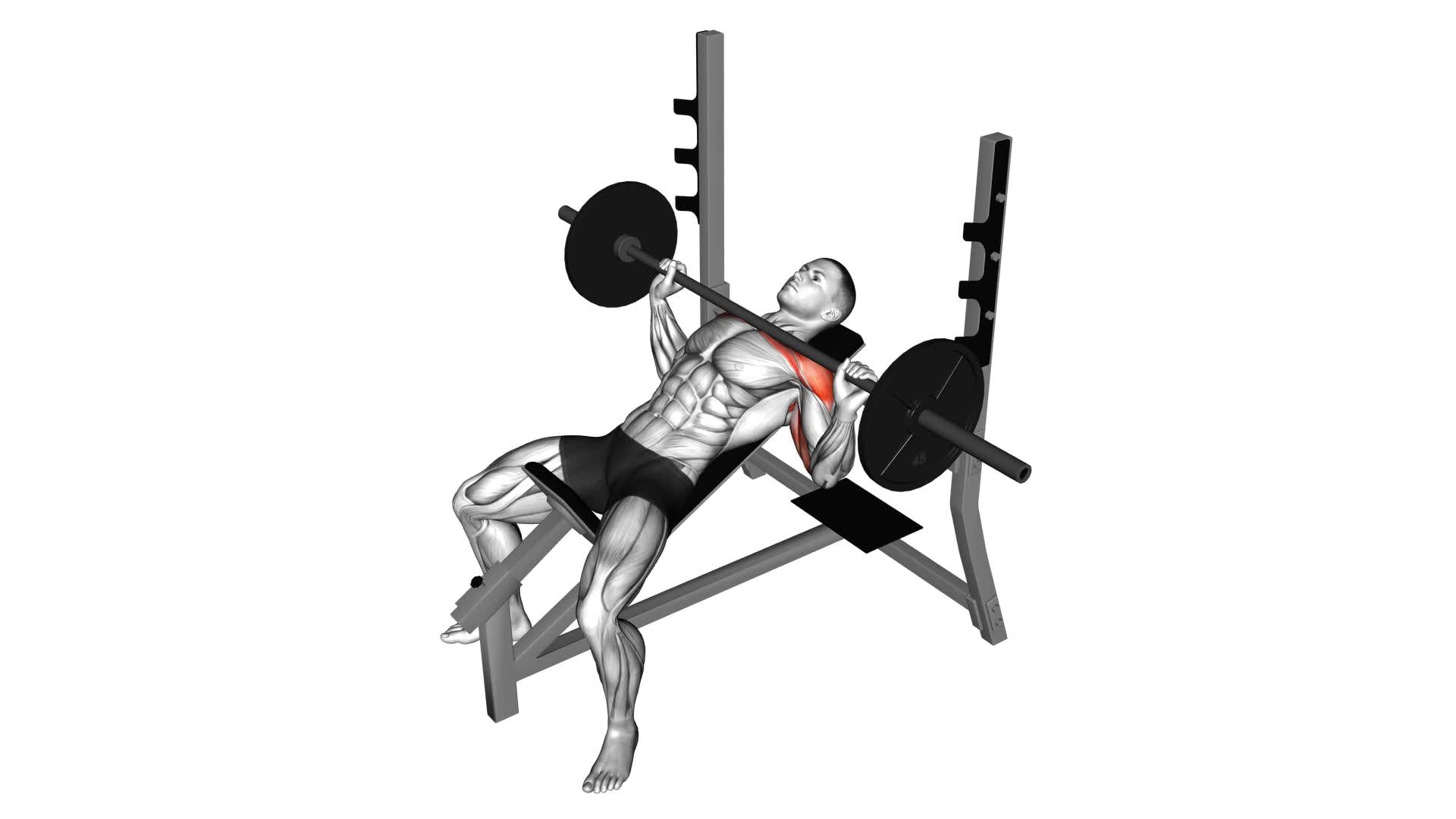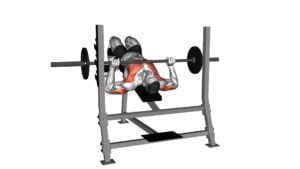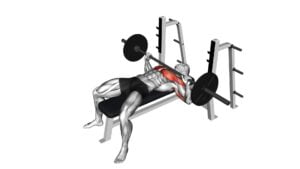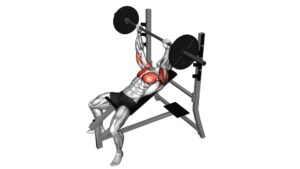Barbell Pause Incline Bench Press – Video Exercise Guide & Tips

Are you looking to level up your upper body strength? Well, look no further!
Watch This Exercise Video
The barbell pause incline bench press is a fantastic exercise that targets your chest, shoulders, and triceps.
In this article, we'll guide you through the proper form and technique, provide tips for maximizing your results, and even offer variations and modifications to keep things interesting.
So grab a barbell and get ready to take your upper body training to new heights!
Key Takeaways
- Increased muscle activation
- Improved upper body strength
- Greater muscle fiber recruitment
- Increased time under tension
Benefits of Barbell Pause Incline Bench Press
You can experience increased muscle activation and improved upper body strength with the use of a barbell pause during your incline bench press. Incorporating a barbell pause into your incline bench press variations can provide numerous benefits and help you achieve better results.
One of the main benefits of adding a pause to your incline bench press is increased muscle activation. By pausing at the bottom of the movement, you force your muscles to work harder to initiate the upward phase of the exercise. This increased activation leads to greater muscle fiber recruitment and ultimately, more strength gains.
In addition to increased muscle activation, incorporating a barbell pause can also help improve your upper body strength. The pause at the bottom of the movement forces your muscles to hold the weight in a static position, which increases the time under tension and challenges your muscles in a different way. This increased time under tension can lead to greater strength gains and improved overall upper body strength.
To get the most out of your barbell pause incline bench press, here are a few tips for better results. First, make sure to maintain proper form throughout the exercise. Keep your core engaged, your back flat against the bench, and your elbows at a 45-degree angle.
Secondly, focus on controlling the weight during both the lowering and lifting phases of the movement. This will help maximize muscle activation and prevent any unnecessary strain on your joints.
Lastly, gradually increase the weight over time as your strength improves to continue challenging your muscles and promoting growth. By incorporating these tips and variations into your barbell pause incline bench press, you can experience increased muscle activation and improved upper body strength.
Proper Form and Technique
To perform the Barbell Pause Incline Bench Press with proper form and technique, there are several key points you need to focus on.
First, it's crucial to pay attention to your elbow position, keeping them tucked in and not flaring out to the sides.
Secondly, mastering the art of breathing and bracing will help you maintain stability and generate more power during the exercise.
Lastly, controlling the bar path throughout the movement is essential for maximizing muscle engagement and preventing unnecessary strain on your joints.
Elbows Position Importance
Maintaining the proper position of your elbows is crucial for achieving optimal form and technique during the Barbell Pause Incline Bench Press exercise.
The position of your elbows plays a significant role in determining the muscle activation and benefits you can derive from this exercise. To ensure proper elbow positioning, start by keeping your elbows at a 45-degree angle to your torso.
This position allows for maximum activation of the chest muscles while minimizing stress on the shoulder joints. It also helps to engage the triceps and shoulders, promoting overall upper body strength development.
Breathing and Bracing
To ensure optimal form and technique during the Barbell Pause Incline Bench Press exercise, it's important to focus on proper breathing and bracing techniques.
Breathing techniques play a crucial role in maintaining core stability and maximizing power output during the exercise. Before starting the movement, take a deep breath in and brace your core by contracting your abdominal muscles as if you were preparing to be punched in the stomach. This will help create intra-abdominal pressure, providing a stable base for the exercise.
As you lower the barbell to your chest, exhale slowly and steadily, maintaining tension in your core. Remember to inhale again at the top of the rep before starting the next repetition.
Bar Path Control
Focus on controlling the bar path to maintain proper form and technique during the Barbell Pause Incline Bench Press exercise, allowing for optimal muscle activation and strength gains.
Bar path control is crucial in this exercise to ensure that the barbell moves in a straight line throughout the movement. Keep the barbell directly over your chest and avoid any deviations from this path. This will help to target the intended muscle groups, such as the chest, shoulders, and triceps, effectively.
Tempo training can be beneficial in improving bar path control. By emphasizing a slow and controlled descent of the barbell, followed by an explosive push back up, you can develop better control and stability throughout the movement. This will lead to increased muscle activation and overall strength gains.
Now, let's move on to the equipment needed for the exercise.
Equipment Needed for the Exercise
You will require specific equipment for the Barbell Pause Incline Bench Press exercise. This exercise is typically performed using a barbell, an incline bench, and weight plates. The barbell is a long metal bar with weights attached to each end. It allows for a greater range of motion and stability compared to dumbbell alternatives. The incline bench is an adjustable bench that can be set at various angles, typically between 30 to 45 degrees. This angle targets the upper chest muscles more effectively.
When performing the Barbell Pause Incline Bench Press, it's important to select an appropriate weight that challenges you but still allows for proper form and control. Start with a weight that you can comfortably handle and gradually increase as you become stronger. Make sure to secure the weights on the barbell using collars to prevent them from sliding off during the exercise.
In addition to the barbell and incline bench, you may also use accessories such as weightlifting gloves or wrist wraps for added grip and support. However, these are optional and not necessary to perform the exercise effectively.
Common Mistakes to Avoid
To ensure you get the most out of your barbell pause incline bench press, it's important to avoid common mistakes.
First, make sure your hand placement is correct to maintain proper form and prevent strain on your wrists.
Secondly, be mindful of your range of motion, ensuring you go through a full range of motion to engage all the target muscles effectively.
Lastly, pay attention to your form, keeping your back and core engaged throughout the exercise to maximize results and prevent injury.
Incorrect Hand Placement
One common mistake to avoid when performing the Barbell Pause Incline Bench Press is having improper hand placement. It's important to have the correct hand placement to ensure proper form and maximize the effectiveness of the exercise while minimizing the risk of injury.
One hand placement error to avoid is placing your hands too wide apart on the barbell. This can put excessive stress on the shoulders and increase the risk of shoulder impingement or rotator cuff injuries.
On the other hand, placing your hands too close together can limit your range of motion and decrease the activation of the chest muscles.
To prevent these hand placement errors, make sure your hands are positioned slightly wider than shoulder-width apart, with a firm grip on the barbell. This will help maintain stability and promote optimal muscle engagement while reducing the risk of injury.
Limited Range of Motion
Avoiding a limited range of motion is crucial when performing the Barbell Pause Incline Bench Press. It can hinder the effectiveness of the exercise and potentially lead to imbalanced muscle development.
To maximize gains and avoid injury, it's important to ensure that you're moving the barbell through a full range of motion during each repetition. A common mistake to avoid isn't lowering the barbell all the way down to your chest or not extending your arms fully at the top of the movement.
Lack of Proper Form
To avoid lack of proper form and common mistakes in the Barbell Pause Incline Bench Press, focus on maintaining proper form and executing each repetition with a full range of motion. Here are some common errors to avoid:
- Using improper technique: Ensure that your back, shoulders, and glutes are firmly pressed against the bench throughout the entire movement. This helps maintain stability and prevents excessive strain on the lower back.
- Flaring the elbows: Keep your elbows tucked in at about a 45-degree angle to your body. This engages the chest muscles effectively and reduces stress on the shoulders.
- Lifting your hips: Avoid lifting your hips off the bench during the exercise. This can lead to a loss of stability and compromise your form.
- Neglecting the pause: Remember to pause for a second at the bottom of the movement with the barbell touching your chest. This increases the challenge and ensures you're utilizing the full range of motion.
By focusing on correct form and avoiding these common errors, you'll maximize the effectiveness of the Barbell Pause Incline Bench Press.
Now, let's explore some variations and modifications to keep your workouts interesting and challenging.
Variations and Modifications
Use heavier weights to increase the intensity of your Barbell Pause Incline Bench Press. While the standard Barbell Pause Incline Bench Press is an effective exercise, there are variations and modifications that you can incorporate to target different muscle groups and add variety to your workout routine.
One variation is the Dumbbell Pause Incline Bench Press. Instead of using a barbell, you use dumbbells for this exercise. This variation allows for a greater range of motion and can help to improve muscle imbalances.
Another variation is the Smith Machine Pause Incline Bench Press. This variation is performed using a Smith machine, which provides stability and allows you to focus on the pressing movement.
If you want to modify the exercise, you can try the Incline Dumbbell Fly. Instead of pressing the weights, you perform a fly motion, which targets the chest muscles in a slightly different way.
Another modification is the Resistance Band Pause Incline Bench Press. By adding resistance bands to the exercise, you increase the tension throughout the movement, making it more challenging.
Incorporating these variations and modifications into your workout routine can help to keep your workouts interesting and prevent plateauing. Remember to always use proper form and start with lighter weights before progressing to heavier ones.
Tips for Maximizing Your Results
To maximize your results, incorporate these tips into your Barbell Pause Incline Bench Press routine:
- Increase the weight gradually: Start with a weight that challenges you but allows you to maintain proper form. As you become stronger, gradually increase the weight to continue challenging your muscles and maximizing gains.
- Focus on proper form: Ensure that your back is flat against the bench, and your feet are planted firmly on the ground. Maintain a controlled and smooth movement throughout the exercise, avoiding any jerky or excessive movements. This will help you target the chest muscles effectively and minimize the risk of injury.
- Utilize a pause at the bottom: When you lower the barbell to your chest, pause for a moment before pushing it back up. This pause increases the time under tension for your muscles, making the exercise more challenging and promoting muscle growth.
- Vary your grip width: Experiment with different grip widths to target different areas of the chest. A wider grip emphasizes the outer chest, while a narrower grip targets the inner chest. Switching between different grip widths can help maximize gains and prevent plateauing.
Frequently Asked Questions
How Many Sets and Reps Should I Do for the Barbell Pause Incline Bench Press?
For the barbell pause incline bench press, it's important to determine the right number of sets and reps based on your fitness goals and abilities. Generally, start with 3-4 sets of 8-12 reps.
This exercise targets your upper chest, shoulders, and triceps, and offers benefits such as increased upper body strength and muscle development.
Remember to vary your grip width or use dumbbells for different variations of the barbell pause incline bench press.
Can I Perform the Barbell Pause Incline Bench Press With Dumbbells Instead of a Barbell?
Yes, you can perform the incline bench press with dumbbells instead of a barbell. Using dumbbells provides more stability training and targets each side of your body independently.
It also allows for a greater range of motion. Dumbbells can be a great alternative if you have any wrist or shoulder issues.
Just make sure to choose a weight that challenges you and maintain proper form throughout the exercise.
Should I Incorporate the Barbell Pause Incline Bench Press Into My Upper Body or Lower Body Workout Routine?
If you're wondering whether to incorporate the barbell pause incline bench press into your upper or lower body workout routine, consider the benefits and variations.
This exercise primarily targets your upper body, specifically your chest, shoulders, and triceps. It can help improve upper body strength and muscle definition.
However, it may not be suitable for beginners or those with shoulder or chest injuries. Remember to consult a professional trainer for personalized advice on incorporating this exercise into your routine.
Can Beginners Perform the Barbell Pause Incline Bench Press, or Is It More Suitable for Advanced Lifters?
Beginners can definitely perform the barbell pause incline bench press. It's not just for advanced lifters. In fact, it can be a great exercise for beginners to build strength and muscle in their upper body.
The pause in the middle of the movement helps improve stability and control. Plus, there are variations of this exercise that can be adjusted to different fitness levels.
How Long Should I Pause at the Bottom of Each Repetition During the Barbell Pause Incline Bench Press?
When performing the barbell pause incline bench press, it's important to know how long to pause at the bottom of each repetition. To properly execute this exercise, the pause should be around 1-2 seconds.
This brief pause allows for increased time under tension, targeting your chest muscles more effectively. By pausing, you also eliminate any momentum and engage your muscles fully.
Remember to maintain proper form and control throughout the movement for optimal results.
Conclusion
The barbell pause incline bench press is a highly effective exercise for building upper body strength and muscle. By pausing at the bottom of each rep, you engage your chest, shoulders, and triceps even more.
Remember to maintain proper form and technique, using the appropriate equipment. Avoid common mistakes such as arching your back or lifting too heavy.
Explore variations and modifications to challenge yourself and maximize results. Follow these tips to achieve your fitness goals with this exercise.

Author
Years ago, the spark of my life’s passion ignited in my mind the moment I stepped into the local gym for the first time. The inaugural bead of perspiration, the initial endeavor, the very first surge of endorphins, and a sense of pride that washed over me post-workout marked the beginning of my deep-seated interest in strength sports, fitness, and sports nutrition. This very curiosity blossomed rapidly into a profound fascination, propelling me to earn a Master’s degree in Physical Education from the Academy of Physical Education in Krakow, followed by a Sports Manager diploma from the Jagiellonian University. My journey of growth led me to gain more specialized qualifications, such as being a certified personal trainer with a focus on sports dietetics, a lifeguard, and an instructor for wellness and corrective gymnastics. Theoretical knowledge paired seamlessly with practical experience, reinforcing my belief that the transformation of individuals under my guidance was also a reflection of my personal growth. This belief holds true even today. Each day, I strive to push the boundaries and explore new realms. These realms gently elevate me to greater heights. The unique combination of passion for my field and the continuous quest for growth fuels my drive to break new ground.







